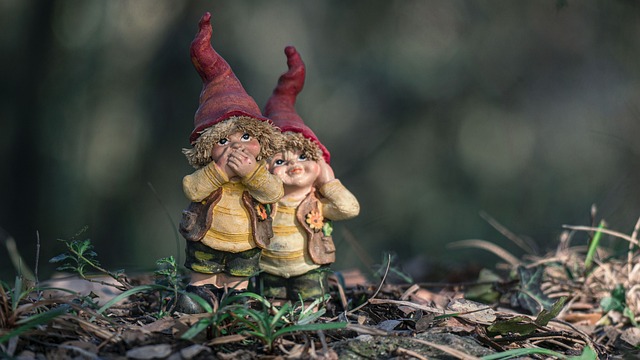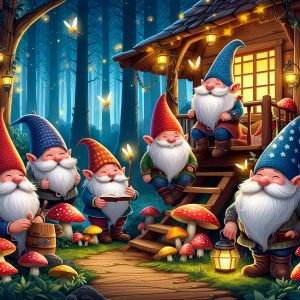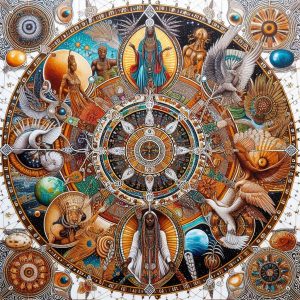Gnomes have a rich cultural significance that spans folklore, mythology, and modern popular culture. These small, earth-dwelling creatures are often associated with nature, magic, and hidden treasures. Their roles and meanings have evolved across different cultures, but they continue to symbolize various aspects of human interaction with the natural and mystical world.
1. European Folklore and Mythology
Gnomes originally appear in European folklore, particularly in Germanic and Scandinavian cultures. They are often depicted as small, bearded men who live underground, guarding treasures and the natural world. Their role in these early traditions reflects themes of:
- Guardians of the Earth: Gnomes are thought to be protectors of underground treasures like precious metals and gems. This ties them to the material and earthly realm.
- Nature Spirits: As earth spirits, gnomes are seen as caretakers of the natural environment. They symbolize the connection between humans and nature, reminding people to respect and protect the earth’s resources.
In some versions of the mythology, they are also known for their wisdom and practical knowledge of the earth’s secrets, making them figures of mystery and reverence.

2. Renaissance and Alchemical Tradition
During the Renaissance, the concept of gnomes was formalized by Paracelsus, a Swiss alchemist and physician. He categorized gnomes as one of the four elemental beings, associated with the element of earth (the others being sylphs for air, undines for water, and salamanders for fire). In this context, gnomes represented the foundational qualities of the earth—solidity, stability, and materiality.
- Esoteric Symbolism: In alchemical and esoteric traditions, gnomes symbolize hidden knowledge and transformation. They are the embodiment of the material plane, but their connection to treasure also suggests deeper, often hidden, spiritual or philosophical wisdom.
3. 19th-Century Romanticism and Fairy Tales
The 19th-century Romantic movement revived interest in folklore, nature, and the supernatural. Gnomes, along with other mythical creatures like fairies and elves, gained prominence in art, literature, and children’s stories. They came to symbolize the mysterious forces of nature and the imagination.
- Children’s Literature: In stories and fairy tales, gnomes are often portrayed as helpful, sometimes mischievous, beings. They are portrayed as protectors of the forest and animals, representing nature’s hidden guardians. This depiction has made them enduring figures in children’s stories and a way to teach respect for nature.
4. Modern Popular Culture
In the 20th and 21st centuries, gnomes have become a staple in fantasy literature, films, and games. They’ve taken on various roles, often depicted as quirky, magical beings with knowledge of the earth or technology. Their cultural significance in modern times often blends their folklore origins with whimsical, sometimes comedic, representations:
- Fantasy Literature and Games: Gnomes appear in works like J.R.R. Tolkien’s Middle-earth and role-playing games such as Dungeons & Dragons. Here, they are often portrayed as inventors or tinkerers, building on the idea of their practical knowledge from folklore.
- Garden Gnomes: The cultural icon of the garden gnome emerged in 19th-century Germany, spreading across Europe and later globally. These figurines represent good luck, protection, and a connection to nature. Placing a gnome in the garden is seen as a way to bring prosperity and ensure that plants thrive.
- Pop Culture Figures: Gnomes are also featured in animated films, advertisements, and television shows, often symbolizing whimsy and lightheartedness. Movies like Gnomeo & Juliet or the Travelocity gnome character blend the playful side of gnomes with modern humor.
5. Symbol of Environmental Stewardship
Given their long-standing association with the earth and natural resources, gnomes have also become symbols of environmental stewardship in some modern interpretations. They represent a reminder to care for the planet, echoing ancient beliefs about their role as nature’s protectors.

6. Psychological Symbolism
On a psychological level, gnomes can represent the “hidden self” or the subconscious mind. They dwell underground, often in the dark or beneath the surface, which can symbolize the hidden or unexplored parts of the human psyche.
Key Themes in the Cultural Significance of Gnomes:
- Guardianship of Nature and Earth: As spirits connected to the earth, gnomes are often seen as guardians of nature and its resources.
- Hidden Knowledge and Mystery: Whether as treasure protectors or mystical beings, gnomes symbolize the unseen, mysterious aspects of life and the natural world.
- Luck and Prosperity: Garden gnomes in particular are often seen as symbols of good fortune and protection.
- Whimsy and Imagination: In modern culture, gnomes often represent lightheartedness and the magic of the imagination.
Overall, gnomes continue to be a multifaceted symbol, embodying everything from ancient wisdom and protection of nature to modern whimsy and playful creativity.





